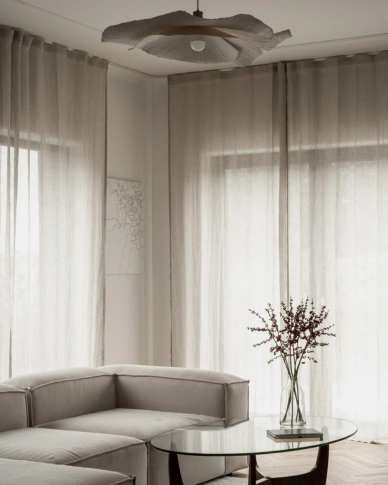Inspirations
Japandi style – what is this design and how to decorate an interior in a japandi climate?
- Data publikacji:
Table of contents
What is the japandi style? Features
Japandi style is a combination of Japanese and Scandinavian design. As you can easily guess, the name is derived from a combination of the words Japan and Scandi. Its history is remarkable – in the mid-19th century Danish designers, architects and artists, looking for inspiration abroad, traveled to the Far East. Among Asian countries, their attention was particularly drawn to Japan – the cherry blossom is synonymous with simplicity and rustic minimalism. Such an exchange of cultural experiences resulted in a new design, which for decades has been popular not only in Scandinavia, but even around the world. In japandi, the home is meant to be a refuge, a cocoon that allows you to relax. It’s not a fad, but a universal, timeless style.
Features of japandi include:
- simplicity and minimalism – japandi is distinguished by simple forms, lack of unnecessary ornamentation and focus on the necessary elements.
- natural materials – the style uses natural materials such as wood, linen fabrics, ceramics, cotton, clay or stones.
- bright colors – japandi is based on light, matte and subdued colors, such as white, gray, beige, browns, pale greens and pastel shades.
- Combination of tradition and modernity – japandi style combines elements of traditional Japanese design with modern Scandinavian solutions.
- harmony and balance – the japandi trend promotes balance, moderation and harmony, so the furniture and accessories are selected to form a coherent whole.
- functionality and ergonomics – japandi interiors are meant to soothe the senses, promote relaxation and quiet the mind.
- Open, orderly spaces – japanese will be best found in spacious spaces with simple lines, which is conducive to building a zen and hygge atmosphere.
- cozy atmosphere – despite its simplicity, the style can be described as cozy and warm.
- top quality and remarkable craftsmanship – japandi interiors are dominated by high quality furniture and accessories, often made by hand and with great care.
How to arrange japandi style in your own apartment?
Japandi style furniture
Furniture in the japanese climate is characterized by simplicity and elegance. They are most often made of natural materials, such as wood, bamboo, rattan or wicker. They have simple, geometric shapes with subtle decorations and are low - the latter feature, of course, refers to Japan. A characteristic feature of japandi furniture is also that it is often multifunctional - for example, a bed can also be a seat or table, and a coffee table also serves as a flower stand. If you opt for wooden furniture, it's worth betting on models with a distinct texture achieved by planing, brushing, aging and hand beveling. In addition to classic bookcases, shelves, sofas or beds, an interesting option will also be tatami, which are traditional mats for sitting and lying made of different types of plants, such as bamboo, reeds and straw. They are particularly popular in Japan, where they are used for resting as well as decorating living rooms and bedrooms.
Japandi style fabrics
If you are looking for fabrics in a japanese climate, be sure to consider those with simple, neutral colors and geometric patterns, as well as natural and organic materials. In this role, linen will be perfect - timeless, subtle, elegant and cozy. In japandi arrangements it is worth hanging linen curtainsand decorate the table with with a linen tableclothand in the bedroom wrap the body with linen sheets. The material is durable and stain resistant to stretching, which goes well with the philosophy of japandi, where quality matters. Other fabrics ideal for Scandinavian-Japanese arrangements are cotton, silk, wool, jute, but also traditional Japanese fabrics such as fusyma or kakemono. You can opt for accessories made from them, such as makatas, plaids, trays, poufs or rugs.
Japanese-style accessories
Japandi is characterized by simplicity and elegance, so limit the number of decorations and objects to the bare minimum. What additions will not overwhelm the interior, and will even emphasize its unique atmosphere? First of all, it is worth introducing elements of Japanese design into the arrangement. Absolute must-have are bonsai trees and hanging pots with bamboo vines. Shoji, which are sliding doors or partitions made of paper or other transparent materials, will also prove interesting. They are used in Japanese homes to separate rooms or to create zen spaces. Trays made of mangrove wood are also often spotted in japandi style arrangements. They will allow you to organize the items on the coffee table, and add an oriental atmosphere to the interior. Although the japandi style is based on simple and subdued colors, you can add some color accents, such as red or blue pillows or posters with floral motifs.
Japanese-style lighting
The right light - bright, diffused, subtle - is also important in japandi style. Lanterns are typical accessories in the Japanese style, which can be used as lighting or decoration. They are often made of paper and can be hand-painted or decorated.In contrast, japandi style lamps are made of natural materials, such as bamboo or wood. Models with paper lampshades further add lightness and subtlety to the interior. In japandi it is the atmosphere that counts, and candles are a simple and elegant way to emphasize the atmosphere of the Far East. You can find candles in a variety of shapes, sizes and scents that will give the room a warm and cozy atmosphere.
Interior japandi - minimalism, but with an idea!
Interiors that soothe the senses are the perfect answer to the rush and overstimulation that accompany us every day. In a japanese apartment you can calm down, relax and enjoy the tranquility and proximity to nature. Their arrangement is not difficult, but it is worth sticking to a few rules, which we mentioned above. And if you are looking for the right accessories in the atmosphere of japandi, take a look at our store. W IL LETTO you will find textiles made of high-quality linen, which will perfectly emphasize the simplicity of the arrangement and add to its cozy atmosphere.





